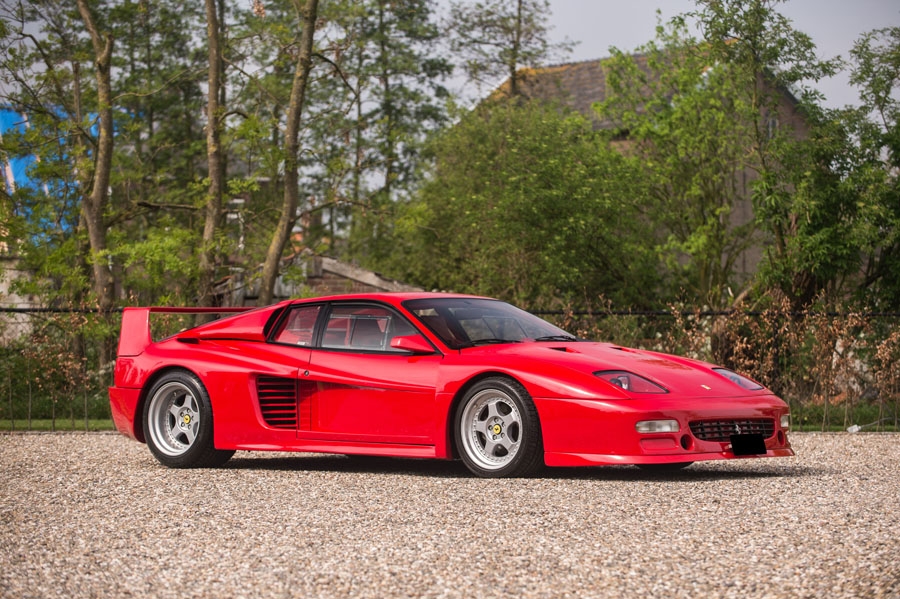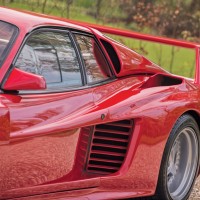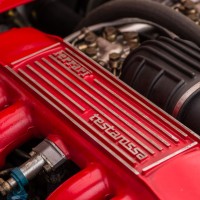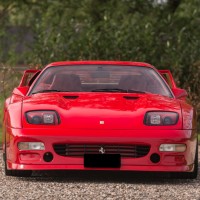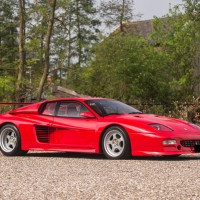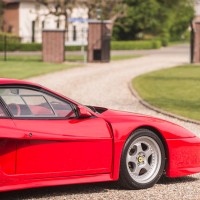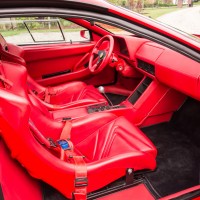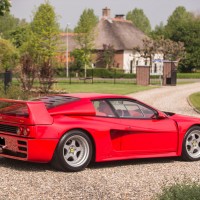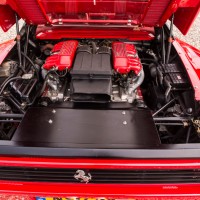For some people, the best is not enough. In 1984, the Koenig Workshop, a German preparer based in Munich, developed an extreme high-performance car that was given the name Ferrari Testarossa Koenig Competition Evolution. As the name reveals, the model used as a starting point was extraordinary in its own right, as the Testarossa was a car that ordinary mortals could only dream of.
However, Koenig went even further, making this supercar a hypercar before its time. Clients could get 1,000 or more horsepower if requested. Meticulously re-worked running gear set on a widened track, stabilizers, anti-roll bars and wide rims were a standard upgrade. The cars were equipped with a special stainless-steel sports exhaust system and comprehensively modified body panels. The interior was also revised, with omnipresent leather upholstery available in a wide choice of colors. From the start, the car left no doubt about its road-going capabilities. Where the “ordinary” Testarossa had set a new benchmark for its performance, the Koenig version surpassed this with ease.
This car has a complete conversion of the body and the majority of the other modifications. The original Rosso Corsa color was retained, and it has matching leather interior. Although the V12 engine is naturally aspirated, its power has reportedly been increased to 800 horsepower, allowing the car to travel from 0 to 100 km/h (62 mph) in 3.5 seconds. Nevertheless, the current owner says the car is easy to drive.
With 45,603 km (28,336 miles) on the clock today, the car has recently benefited from a full service at Forza Service in Holland, and it is presented in immaculate condition.
SCM Analysis
Detailing
| Vehicle: | 1987 Ferrari Testarossa Koenig Competition Evolution II |
| Number Produced: | About 21 |
| Original List Price: | $120,000, plus $30,000 for Koenig conversion |
| Distributor Caps: | $500 |
| Chassis Number Location: | On top of steering column |
| Engine Number Location: | Pad forward of cylinder head on right side |
| Club Info: | Ferrari Club of America |
| Website: | http://www.ferrariclubofamerica.org |
| Alternatives: | RUF Porsche 911, AMG Mercedes Hammer, Michelotto 308 GTB |
| Investment Grade: | C |
This car, Lot 220, sold for $161,969, including buyer’s premium, at Artcurial’s Le Mans Classic auction on July 5, 2014.
The European counterpart of a U.S. speed shop is called a tuner. Like their American brethren, tuners are often frustrated racers selling parts and services to finance a racing jones.
Some tuners, such as Alpina or Brabus, are like Carroll Shelby and align themselves with a major manufacturer. They work with the manufacture to produce a product that respects the manufacturer’s philosophy. They are rewarded with distribution through the manufacturer’s dealer network and factory warranties.
Other tuners are outlaws — building variations of the manufacturer’s products that are not necessarily complementary to the manufacturer’s image. Willy Koenig’s Koenig Specials falls in the latter category.
Hot-rodding Ferraris
Racing and Ferraris run through Willy Koenig’s blood. The Koenig Specials website reports that he won the 1962 German Mountain Climb Championship in a Ferrari 250 SWB. Later he apparently raced a competition 275 GTB and an assortment of non-Ferrari sports cars. The website notes Enzo Ferrari personally invited Koenig to Maranello for an event to honor his Mountain championship. That was a decision Ferrari may have later regretted.
Legend has it that Koenig was unhappy with the performance of his new Ferrari 365 Boxer, so he sent it to a tuner for upgrades. He was so pleased with the results that he started Koenig Specials to market modified Ferraris. Unlike most tuners, Koenig was a businessman rather than a mad scientist. At first, the business outsourced their design and production to other specialists, but as the business grew, Koenig hired a staff, and most work was performed in-house.
Koenig’s early focus was on Ferraris, particularly Boxers and 308s. Later he added Mercedes, Porsche and even Lamborghini models to his offerings. Modifications available were limited only by imagination, but they generally included a body modification, with interior and performance upgrades.
Drivetrain-twisting power
One of my customers had Koenig build two Testarossas for him. The first was a twin-turbo Competition with mild body mods. When Koenig developed his more radical “Competition Evolution,” the customer traded us his first Koenig for a brand-new Testarossa, which he sent across the pond for the new Koenig treatment.
The car returned with a color change, chopped top, ostrich interior, twin turbochargers, and a supercharger that boosted power until the turbos kick in. It proudly wore a badge noting its 1,000 horsepower. It also featured a Plexiglas window in the hood, displaying the engine for everyone to see.
The Testarossa’s drivetrain wasn’t designed to handle 1,000 horsepower, and after twisting two axles — and then breaking a transaxle — the car was sent to us to sell.
A man from Las Vegas came out to Atlanta to buy the car. He had a busy schedule and could only arrange to come in on a 2 a.m. flight — and then leave at 6 a.m. We did a 3 a.m. test drive. The client did several low- to high-speed runs at full throttle down a nearly deserted beltway. The exhaust was open except for the turbochargers, and in the silent night you could hear our antics miles away. It’s a wonder that we didn’t end up in jail.
A couple of years later, we got a call from the same client. He was in a federal correctional facility and was interested in buying an F40 when he got out. Before he hung up, he passed the phone to another guest of the feds. The second guy turned out to be the man who bought that first Koenig Testarossa from us. They had been talking cars in the cafeteria and discovered the Koenig connection.
Koenig Ferraris are polarizing cars. Koenig made 1,000-hp street cars in an era when 400 hp put you near the top of the horsepower chain. It would be more than 15 years before Bugatti bettered the number with their Veyron. The brute power and outrageous cosmetics put Koenig Specials on the cover of magazines worldwide. It was hard not to daydream about what all that power would feel like on the road. On the other hand, purists view modifying a Ferrari as blasphemy and would ostracize a Koenig Ferrari at most Ferrari events.
A strong price for a polarizing car
Artcurial’s Testarossa was a Koenig Competition Evolution II model. It featured a normally aspirated motor. Despite the vendor’s 800-hp claim, without turbos, it probably packed no more than 450 horses.
The body modifications were reasonable and restrained, with an F40-inspired rear end and an F512 M-inspired front end. The interior was a bit over the top, with custom design done in lipstick-red leather. The car appears to have a well-known history and has been in the hands of enthusiasts who appreciated it. It also appeared to be in very good condition.
It’s said that Enzo Ferrari despised Koenig’s creations and demanded Koenig remove the Ferrari logos from his cars. Apparently, not everyone felt the same way. Artcurial’s car sold near the top of its estimate — and as much as $100,000 more than a non-Koenig version of the car would bring. The premium covered the cost of the conversion and then some.
Willy Koenig had his share of cover cars, but this wasn’t one. This car has the Koenig look, but without the expensive blowers it misses the outrageousness that’s the Koenig hallmark. The seller should be happy with his purse. The buyer got center-ring attention without the worry of hand-grenade mechanicals. Nobody got hurt in this battle. ♦
(Introductory descriptions courtesy of Artcurial.)
